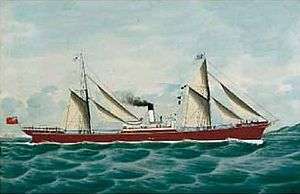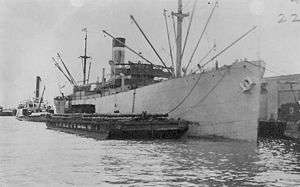Short Brothers of Sunderland

Short Brothers Limited was a British shipbuilding company formed in 1850 and based at Pallion, Sunderland since 1869. The company closed in 1964 when it failed to invest to build bigger ships.[1]
19th century
In 1850 George Short founded a shipyard at Hylton[1] to build small wooden ships for local users. In 1860 Short moved the yard downriver to Pallion and his four sons became partners in the business.[1] In 1871 the yard built its first iron-hulled ship the High Stretfield and the company started using the name Short Brothers.[1] John Y Short became a distinguished naval architect and at the 1878 Paris Exhibition he was awarded a gold medal.[1]
In 1883 Short's built a cargo liner for James Knott's Prince Line of Newcastle upon Tyne.[1] This was the beginning of a 35-year relationship in which Short's supplied Prince Line with a total of 37 ships.[1] They included the passenger liner SS Spartan Prince, built in 1897, which spent its early years of service carrying thousands of Italian migrants to the USA.[2]
In 1895 John Y Short made a substantial investment in John Thomas North's Nitrate Producers' Steamship Company Ltd ("Anglo Line"). [1] Short's went on to supply the line with 30 ships, starting with SS Colonel J.T. North[1] and continuing until at least 1929.[2]
From 1897 Short's undertook contract work for several Tyneside shipyards.[1] In 1900 John Y Short died, his brother Joseph took over and the business was converted from a partnership into a limited company, Short Brothers Limited.[1] The yard now employed 1,500 people.[1]
20th century
In the First World War the yard built 14 barges for the Admiralty, plus merchant ships including four cargo ships to the War Shipping Controller's standard B type design.[1] After the war Short's built its first two turbine steamers;[1] the 7,607 GRT sister ships TS Sandown Castle (1921) and TS Sandgate Castle (1922) for Union-Castle Line.
During the 1920s shipbuilding declined.[1] Short's workforce struck in 1923 and 1926 and the yard closed in June 1930.[1]

In 1933 Short's reopened to build SS Arcwear, a tramp steamer designed by Joseph Isherwood.[1] She was the first of Isherwood's new "arcform" design, which increased cargo capacity by 10% and increased speed, but also reduced fuel consumption.[1] Arcwear was launched in November 1933 and made her maiden voyage in 1934.[1] Her fuel economy and speed exceeded expectations but she rolled badly in heavy weather and did not even move smoothly in calm weather.[1] Only a few further arcform cargo ships and tankers were built.[1] In 1938 Short's closed again, despite having a tramp ship still under construction.[1]
In the summer of 1939 Short's reopened again.[1] During the Second World War it built mostly tramp steamers, plus two tankers and one LCT.[1] Under the direction of the Ministry of War Transport by the end of 1944 Short's switched from building ships to its own design to assembling partly prefabricated government standard C-type cargo ships.[1] By the end of the war Short's was employing about 900 people.[1]
In 1946 John H Short was company chairman and H.S. Short, great-grandson of the founder, joined the Board of Directors.[1]
In the early 1960s the Short family did not want to invest in lengthening the yard's berths to build bigger ships.[1] Therefore after Short's launched the universal bulk carrier MV Carlton on 17 October 1963 and completed her in January 1964, they closed the business with the loss of 300 jobs.[1]

- 1889 – SS Magnus Mail – hull 184
- 1892 – SS Hindustan
- 1910 – SS Cacique
- 1918 – SS Clan Macvicar
- 1927 – SS Laristan – hull 425
- 1940 – SS Empire Summer
- 1941 – SS Empire Sun
- 1941 – SS Empire Burton – hull 466
- 1941 – SS Empire Lightning
- 1941 – SS Empire Wycliff
- 1941 – SS Empire Story
- 1942 – SS Empire Bardolph – hull 474
- 1942 – SS Empire Southey
- 1942 – SS Empire Keats
- 1942 – SS Empire Webster
- 1942 – SS Empire Envoy
- 1943 – SS Empire Friendship
- 1943 – SS Empire Camp
- 1943 – SS Empire Stuart
- 1943 – SS Empire Duchess
- 1943 – SS Empire Cromer – hull 480
- 1944 – SS Empire Lagos
- 1945 – SS Empire Nairobi
- 1945 – SS Empire Honduras
- 1945 – SS Empire Dominica
- 1946 – MV Empire Tedburgh
- 1952 – MV Burutu Palm
References
- 1 2 3 4 5 6 7 8 9 10 11 12 13 14 15 16 17 18 19 20 21 22 23 24 25 26 27 28 29 "Short Brothers of Sunderland". The Best of British Engineering 1750s - 1960s. Grace's Guide. 29 January 2009. Retrieved 29 June 2011.
- 1 2 Searle, Peter. "Page 055 The Shipbuilders – page 021". The Sunderland Site. Peter Searle. Retrieved 29 June 2011.